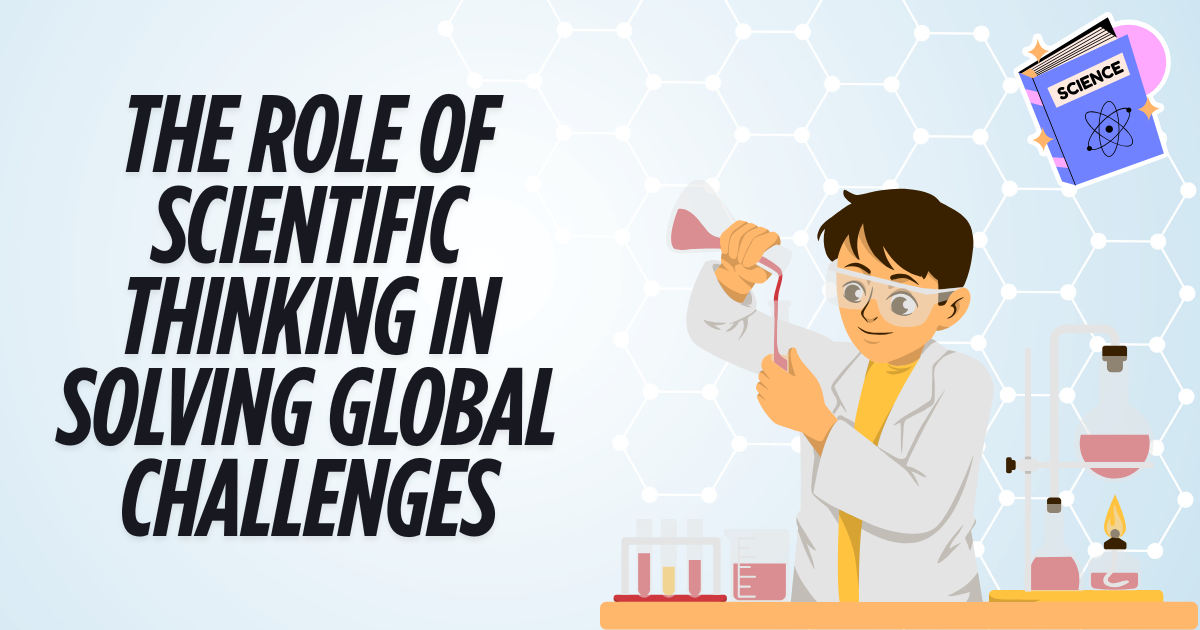The Role of Scientific Thinking in Solving Global Challenges. The Earth is filled with challenges related to air, water, land, humans, medicine, etc. The rapidly evolving science is the key to solving all these challenges that our Earth is facing. No one can identify all the global challenges, but as soon as one arrives, the first initiative is taken by our scientists to resolve it. To know more about the topic “The Role of Scientific Thinking in Solving Global Challenges,” read the complete article.
The Role of Scientific Thinking in Solving Global Challenges
Scientific Thinking plays a significant role in addressing and solving the complicated and interconnected global challenges faced by humanity. The scientific thinking skills cover aspects of logical thinking, analysis, systematic thinking, inductive thinking, and deductive thinking in solving problems that include defining, identifying, formulating alternative solutions and determining the best solutions in solving global warming problems.

The scientists use various methods to solve the ongoing or upcoming problems in the world. The scientific point of view is very important to understand the root cause and the treatments of the problem. The recent example can be taken of COVID-19. The scientists warned people about the importance of masks and informed people about the symptoms and precautions of the disease. The vaccinations were made after studying the virus in detail.
Some of the challenges of this century that scientists can help with are
- Global climate change, including mitigation, adaptation, and intervention
- Sufficient clean water for drinking and agricultural purposes
- Population control and balance of resources
- Work of global information, communications technologies, artificial intelligence, bid data, and cloud computing for everyone
- Energy transition, including efficient electricity generation, transmission, and storage, and carbon-neutral fuels
- Helping human conditions by changing status of women
- Ethnic conflicts, terrorism, and the use of weapons of mass destruction
- Infectious disease and human health
Understanding Global Challenges
The scientist, before reaching any conclusion, performs various steps to understand the global challenges in detail.
Evidence-based Analysis
The first step taken by the scientists is to collect all the data and information about the global challenge. This is to understand the root cause of the problem and if there are any temporary solutions to the problem. They analyze the data to find scope for challenges like climate change, pandemics, water and food scarcity, increasing population, and poverty.
Recognizing Trends and Patterns
Scientists can find patterns and forecast future trends by using statistical methods and modeling techniques, which enables proactive interventions. For example, climate models assist us in understanding the trajectory of global warming and its potential consequences.
Test with an Experiment
Scientists then perform an experiment test to predict whether their prediction is accurate and thus their hypothesis is supported or not. It is crucial for the experiment to be a fair test. The fair test is conducted by ensuring that they change only one factor at a time while keeping all other conditions the same.
Procedure
Professional scientists, in the last step, publish their final report in a scientific journal or by presenting their results on a poster or during a talk at a scientific meeting. The solution is provided to the people to help in solving the global challenge. The necessary steps are taken to provide everyone a fair solution.
Formulating Solutions
Hypothesis Testing and Experimentation
The scientists develop solutions for global challenges by hypothesizing and testing them via experiments and observations. It is crucial to identify the root cause of the problem and find a solution with proof that it will work. The example can be taken of COVID-19. The vaccine was made by testing it on animals first to see if it does not have any harmful side effects on humans.
Innovation and Technological Advancement
The most significant part of scientific research is innovation and development of new technologies that can identify global challenges. Some of the examples of science-based solutions are renewable energy technologies, sustainable agriculture practices, and water purification systems.
Optimization and Efficiency
Scientists work not only on finding new solutions for the global problems but also on working on the existing solutions. These solutions can be optimized and made more efficient to work on. For example, research in material science can lead to the development of more energy-efficient devices and infrastructure.